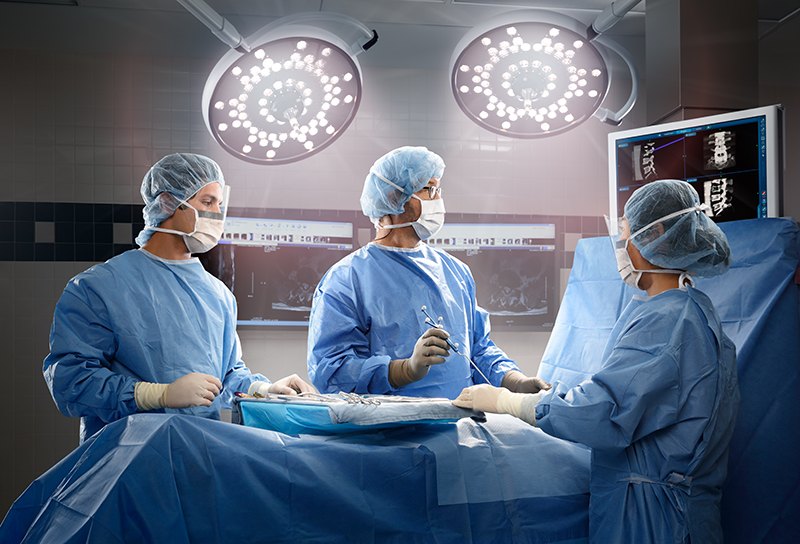Spine Disorders

The spine is a complex structure. One small change in its normal makeup can cause significant pain and disability. Aurora BayCare treats a wide range of spinal disorders. We specialize in complex conditions and those that have failed previous treatment. If you have debilitating pain, spinal fractures, or damage to your spinal nerves, we can help.
Spine Basics
Your spine is made up of bones called vertebrae. These bones are separated by discs. The discs cushion and connect the vertebrae. Discs allow movement and help you maintain proper alignment.
In the center of your backbone, running through the center of the vertebrae and discs, is an open tunnel called the spinal canal. Your spinal cord and spinal nerves are located in this channel.
Problems with your bones or disc can pinch or irritate the nerves. This can cause pain, weakness, or numbness. Some conditions can damage the spinal cord and lead to disability.
Degenerative Disc Disease
Disc disease is a common condition that occurs as we age. We use the word “degenerative” to describe a spine that continues to get worse or decline.
Over time, our spinal discs age and break down. This causes pain and problems for some people. Our discs lose fluid, reducing flexibility and shock absorption. They may crack, bulge, or break. Any of these problems can put pressure on the spinal cord or spinal nerves.
Treatment recommendations typically begin with rest, exercise, physical therapy, and lifestyle modifications. Surgical options may include a discectomy to remove a portion of a disc that is causing nerve compression.
Spinal Fractures
Spinal fractures can cause bone to pinch or damage the spinal cord or spinal nerves. Usually, spinal fractures are the result of an accident, fall, or sports-related injury. Sometimes spinal fractures, such as compression fractures, are caused by osteoporosis or spine tumors.
Depending on the type of fracture, braces may be necessary to immobilize the spine and allow healing. Surgery may be necessary to treat an unstable fracture or to prevent further injury.
Infections
Spinal infections can occur in several parts of the spine, including the bones, the discs, or the space around the spinal cord. Infections may be caused by bacteria or fungus. Symptoms of a spinal infection may include fever, chills, headache, neck stiffness, and pain. Some people may have weakness or numbness in their arms or legs.
The first line of defense is typically medication. Surgery may be required to remove infected tissue or to stabilize the spine if it was damaged by the infection.
Herniated Discs
A herniated disc occurs when the disc tears or ruptures and the gel-like center squeezes out. This gel-like substance can put pressure on the spinal cord or nerve. A pinched or irritated nerve can be painful and may cause numbness or tingling in your arms and legs.
Surgery may be recommended if your symptoms cannot be relieved with more conservative treatments like rest, therapy, and medication. Surgical options may include a microdiscectomy (surgery to remove the portion of the disc pressing against the nerve). Sometimes spinal fusion surgery is also required to stabilize the spine.
Myelopathy
The word “myelopathy” refers to damage to the spinal cord. Some of the most common causes of myelopathy are age-related, including arthritis of the spine, disc degeneration, and bone spurs.
With surgery, our goal is to remove pressure from the spinal cord and prevent your symptoms from getting worse. A damaged spinal cord may heal, but it’s impossible to predict how much. Everyone’s condition and outcome will be different.
Surgical approaches may include a discectomy, laminectomy, and spinal fusion.
Spinal Stenosis
Spinal stenosis is a narrowing of the spinal canal, the bony structure that protects your spinal cord and nerve roots. Symptoms may include numbness, balance or coordination problems, weakness, problems with fine motor control (e.g., buttoning a shirt, writing), or bladder control.
Most of the time, spinal stenosis is a result of disc degeneration and aging. Surgical approaches may include a laminectomy. This involves removing a section of bone to make more room for the spinal cord and nerves.
Spondylolisthesis
This is a common cause of back and leg pain. The term comes from “spondylos,” meaning your back bones, and “oliothesis,” meaning slippage. In other words, spondylolisthesis is a dislocation between two back bones.
Surgery may be recommended if you have severe pain that cannot be relieved with more conservative treatments like therapy, strength conditioning, and medication. Surgical treatment may consist of a laminectomy and spinal fusion.
Spine Trauma
Spine trauma can include spine fractures or spinal cord injury. As a Level II trauma center, Aurora BayCare neurosurgeons can provide expert care to patients with spinal injury.
Spine specialists follow your care from the emergency department to the intensive care unit.
In some cases, spinal cord injuries can lead to paralysis. While there are no treatments to reverse spinal cord damage, some healing may occur in the year after injury. Surgery may be necessary to stabilize the spine and reduce further injury.